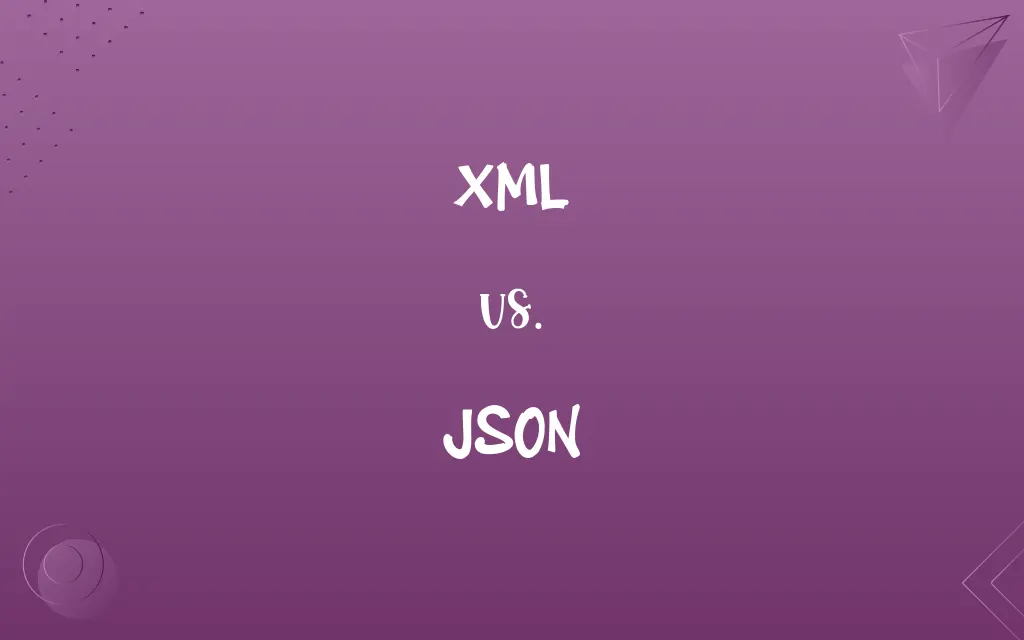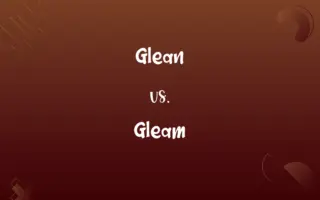XML vs. JSON: Know the Difference

By Shumaila Saeed & Dua Fatima || Published on September 6, 2024
XML is a markup language designed for data storage and transport, with a focus on document structure. JSON is a lightweight data interchange format, emphasizing easy data parsing for web applications.

Key Differences
XML (Extensible Markup Language) and JSON (JavaScript Object Notation) serve as formats for storing and transporting data. XML, being older, is heavily annotated, making it both human- and machine-readable, but also more verbose. It's structured like HTML with opening and closing tags, suitable for complex documents. JSON, in contrast, is more concise, using key-value pairs, making it faster to parse and easier to use with JavaScript, which has led to its widespread adoption in web services and APIs.
Dua Fatima
Sep 06, 2024
XML offers a hierarchical data structure with support for namespaces and attributes, making it ideal for rich document formats, JSON's simplicity focuses on array and object structures. This simplicity translates to less overhead and better performance in web applications. Moreover, JSON's syntax is derived from JavaScript, facilitating its direct use in web development without the need for extensive parsing or transformation.
Shumaila Saeed
Sep 06, 2024
Data type representation is another area where XML and JSON differ. XML treats all data as strings, requiring additional parsing to interpret specific data types. JSON, however, supports basic data types (e.g., numbers, strings, booleans) natively, allowing for a more straightforward data interchange.
Shumaila Saeed
Sep 06, 2024
The choice between XML and JSON often comes down to specific project requirements. XML's strength lies in its ability to represent complex data structures and document formats, making it suitable for publishing and human-readable documents. JSON, with its efficiency and simplicity, is preferred for web APIs, configuration files, and quick data interchange scenarios where payload size and speed are critical.
Shumaila Saeed
Sep 06, 2024
Compatibility with web technologies further distinguishes them. JSON's compatibility with JavaScript makes it the de facto standard for web applications, whereas XML requires XSLT (Extensible Stylesheet Language Transformations) for similar interactions, which can be cumbersome.
Dua Fatima
Sep 06, 2024
ADVERTISEMENT
Comparison Chart
Format
Verbose, with opening and closing tags
Lightweight, using key-value pairs
Dua Fatima
Sep 06, 2024
Data Types
Treats everything as a string; requires parsing
Supports various data types natively (e.g., string, number, boolean)
Shumaila Saeed
Sep 06, 2024
Readability
Human- and machine-readable, but can be cumbersome
More concise and easier to read and write
Shumaila Saeed
Sep 06, 2024
Performance
Slower due to verbosity and complexity
Faster parsing and serialization
Dua Fatima
Sep 06, 2024
Use Cases
Complex document formats, web services
Web APIs, configurations, fast data interchange
Shumaila Saeed
Sep 06, 2024
ADVERTISEMENT
Compatibility
Requires XSLT for web interactions
Directly usable in JavaScript, making it ideal for web applications
Hifza Nasir
Sep 06, 2024
Structure
Hierarchical with support for attributes and namespaces
Primarily array and object structures without attributes
Shumaila Saeed
Sep 06, 2024
Interoperability
High, with broad tool support
High, especially in web environments
Shumaila Saeed
Sep 06, 2024
XML and JSON Definitions
XML
Supports complex structures with attributes.
<book author=John Doe>Title</book>.
Shumaila Saeed
Feb 29, 2024
ADVERTISEMENT
XML
A markup language for document encoding.
XML is used for Microsoft Office document formats.
Dua Fatima
Feb 29, 2024
JSON
Utilizes key-value pairs for data representation.
{name: John Doe, age: 30}.
Shumaila Saeed
Feb 29, 2024
JSON
A lightweight data interchange format.
JSON is commonly used in RESTful APIs.
Dua Fatima
Feb 29, 2024
XML
Extensible and customizable.
XML allows for the definition of custom tags.
Shumaila Saeed
Feb 29, 2024
JSON
Efficient for web applications.
JSON's lightweight nature makes it ideal for AJAX calls.
Shumaila Saeed
Feb 29, 2024
XML
Designed for both humans and machines.
XML documents are readable but can be verbose.
Hifza Nasir
Feb 29, 2024
JSON
Natively supported by JavaScript.
JSON objects can be directly used in JavaScript.
Dua Fatima
Feb 29, 2024
Repeatedly Asked Queries
Are XML and JSON interchangeable?
They are not directly interchangeable due to differences in format, structure, and data type handling, but data can be converted between the two.
Shumaila Saeed
Sep 06, 2024
Can XML and JSON be used together?
While they serve similar purposes, using them together is uncommon. The choice between them usually depends on the specific requirements of the project.
Shumaila Saeed
Sep 06, 2024
Which is faster, XML or JSON?
JSON is generally faster to parse and serialize due to its simpler syntax and lighter weight.
Dua Fatima
Sep 06, 2024
What are XML and JSON?
XML is a markup language for data storage and transport, focusing on document structure. JSON is a data interchange format emphasizing simplicity and speed.
Dua Fatima
Sep 06, 2024
What is the main advantage of XML?
XML's main advantage is its flexibility and ability to represent complex document structures with attributes and namespaces.
Hifza Nasir
Sep 06, 2024
Is JSON only used with JavaScript?
While JSON is derived from JavaScript, it is language-independent and used across various programming languages.
Hifza Nasir
Sep 06, 2024
Can XML be considered outdated?
XML is not outdated but is used in contexts where its specific features, such as customizability and structure, are necessary.
Shumaila Saeed
Sep 06, 2024
How do developers choose between XML and JSON?
The choice depends on the project's specific needs, such as the requirement for complex structures (favoring XML) or speed and simplicity (favoring JSON).
Dua Fatima
Sep 06, 2024
How do XML and JSON handle data types?
XML treats all data as strings, requiring extra parsing for types. JSON supports various data types natively.
Shumaila Saeed
Sep 06, 2024
How has the adoption of JSON impacted web development?
JSON's adoption has simplified data interchange, reduced server load, and improved the speed and responsiveness of web applications.
Hifza Nasir
Sep 06, 2024
Why choose JSON over XML?
JSON is typically chosen for its simplicity, ease of use with JavaScript, and faster parsing, making it ideal for web applications.
Shumaila Saeed
Sep 06, 2024
How do web applications typically use XML and JSON?
Web applications use JSON for quick data interchange and configurations, while XML is used for structured document formats and sometimes in web services.
Dua Fatima
Sep 06, 2024
How do XML and JSON affect web API development?
XML and JSON influence the complexity, speed, and efficiency of data interchange in web API development, with JSON being the preferred format for its simplicity and speed.
Dua Fatima
Sep 06, 2024
What tools are available for working with XML and JSON?
Numerous tools and libraries are available for parsing, validating, and converting data between XML and JSON across various programming languages.
Shumaila Saeed
Sep 06, 2024
Do XML and JSON have different security implications?
Both can be secure, but how they are parsed and used can introduce security risks. Proper handling and validation are essential for both formats.
Hifza Nasir
Sep 06, 2024
Share this page
Link for your blog / website
HTML
Link to share via messenger
About Author
Written by
Shumaila SaeedShumaila Saeed, an expert content creator with 6 years of experience, specializes in distilling complex topics into easily digestible comparisons, shining a light on the nuances that both inform and educate readers with clarity and accuracy.
Co-written by
Dua Fatima






































































